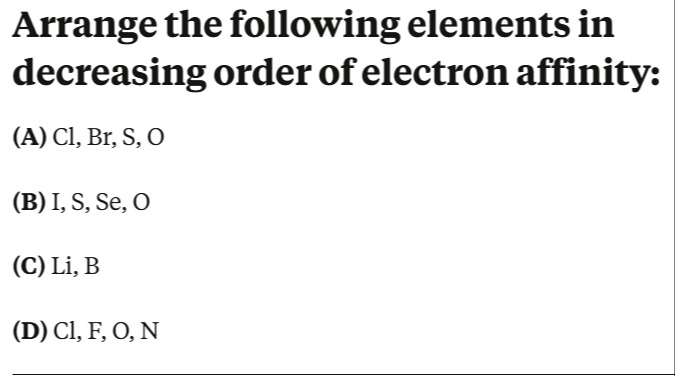Question
Question: Arrange the following elements in decreasing order of electron affinity:...
Arrange the following elements in decreasing order of electron affinity:

(A) Cl > Br > S > O (B) I > S > Se > O (C) B > Li (D) Cl > F > O > N
Solution
To arrange the elements in decreasing order of electron affinity, we follow the general trends and consider exceptions:
General Trends for Electron Affinity:
- Across a period (left to right): Electron affinity generally increases due to increasing effective nuclear charge and decreasing atomic size.
- Down a group (top to bottom): Electron affinity generally decreases due to increasing atomic size and shielding effect.
Key Exceptions/Considerations:
- Second Period Anomaly: For elements in the second period (like F, O, N), their electron affinity is often less than that of the third-period elements in the same group (Cl, S, P). This is due to the very small size of second-period atoms, leading to increased electron-electron repulsion when an extra electron is added.
- Half-filled/Full-filled Orbitals: Elements with stable half-filled (e.g., Nitrogen, Group 15) or full-filled (e.g., Noble Gases, Group 18; Alkaline Earth Metals, Group 2) electronic configurations have very low or even positive electron affinities, meaning they resist gaining an electron.
Let's arrange each set:
(A) Cl, Br, S, O
- Cl (Group 17, Period 3): Highest electron affinity among halogens (except F).
- Br (Group 17, Period 4): Lower than Cl (down the group).
- S (Group 16, Period 3): Lower than Cl (to the left in the same period). Higher than O (down the group, and O is anomaly).
- O (Group 16, Period 2): Lowest in this group due to its small size and electron-electron repulsion (second period anomaly).
- Comparing Br and S: Br is a halogen, S is a chalcogen. Electron affinity of Br (-325 kJ/mol) is higher than S (-200 kJ/mol).
- Decreasing Order: Cl > Br > S > O (Actual values: Cl -349 kJ/mol, Br -325 kJ/mol, S -200 kJ/mol, O -141 kJ/mol)
(B) I, S, Se, O
- I (Group 17, Period 5): Halogens generally have higher electron affinities than chalcogens.
- S (Group 16, Period 3): Higher than Se (down the group) and O (second period anomaly).
- Se (Group 16, Period 4): Lower than S (down the group), but higher than O.
- O (Group 16, Period 2): Lowest among chalcogens due to small size.
- Decreasing Order: I > S > Se > O (Actual values: I -295 kJ/mol, S -200 kJ/mol, Se -195 kJ/mol, O -141 kJ/mol)
(C) Li, B
- Li (Group 1, Period 2): Alkali metal, tends to lose electron, very low electron affinity.
- B (Group 13, Period 2): Electron affinity generally increases across a period. Boron is to the right of Lithium.
- Decreasing Order: B > Li (Actual values: B -27 kJ/mol, Li -60 kJ/mol)
(D) Cl, F, O, N
- Cl (Group 17, Period 3): Highest electron affinity among these due to its position and the second period anomaly of F.
- F (Group 17, Period 2): Lower than Cl (second period anomaly). Higher than O and N (across the period).
- O (Group 16, Period 2): Lower than F (across the period). Higher than N.
- N (Group 15, Period 2): Has a stable half-filled 2p orbital (2p³), making it very resistant to gaining an electron. Its electron affinity is very low (or positive).
- Decreasing Order: Cl > F > O > N (Actual values: Cl -349 kJ/mol, F -328 kJ/mol, O -141 kJ/mol, N +7 kJ/mol)
The final arrangements are: (A) Cl > Br > S > O (B) I > S > Se > O (C) B > Li (D) Cl > F > O > N
Explanation of the solution: Electron affinity generally increases across a period and decreases down a group. Key exceptions include the lower electron affinity of second-period elements compared to third-period elements in the same group (due to small size and electron-electron repulsion), and very low/positive electron affinities for elements with stable half-filled or full-filled electron configurations (like Group 15, Group 2, and Group 18). Applying these trends and exceptions to each set of elements yields the decreasing order of electron affinity.
